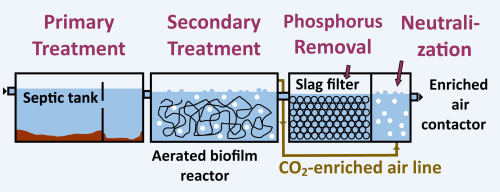当前位置:
X-MOL 学术
›
Water Res.
›
论文详情
Our official English website, www.x-mol.net, welcomes your
feedback! (Note: you will need to create a separate account there.)
Development and modelling of a steel slag filter effluent neutralization process with CO2-enriched air from an upstream bioprocess
Water Research ( IF 11.4 ) Pub Date : 2017-11-03 , DOI: 10.1016/j.watres.2017.11.005 Patricia Bove , Dominique Claveau-Mallet , Étienne Boutet , Félix Lida , Yves Comeau
Water Research ( IF 11.4 ) Pub Date : 2017-11-03 , DOI: 10.1016/j.watres.2017.11.005 Patricia Bove , Dominique Claveau-Mallet , Étienne Boutet , Félix Lida , Yves Comeau

|
The main objective of this project was to develop a steel slag filter effluent neutralization process by acidification with CO2-enriched air coming from a bioprocess. Sub-objectives were to evaluate the neutralization capacity of different configurations of neutralization units in lab-scale conditions and to propose a design model of steel slag effluent neutralization. Two lab-scale column neutralization units fed with two different types of influent were operated at hydraulic retention time of 10 h. Tested variables were mode of flow (saturated or percolating), type of media (none, gravel, Bionest and AnoxKaldnes K3), type of air (ambient or CO2-enriched) and airflow rate. One neutralization field test (saturated and no media, 2000–5000 ppm CO2, sequential feeding, hydraulic retention time of 7.8 h) was conducted for 7 days. Lab-scale and field-scale tests resulted in effluent pH of 7.5–9.5 when the aeration rate was sufficiently high. A model was implemented in the PHREEQC software and was based on the carbonate system, CO2 transfer and calcite precipitation; and was calibrated on ambient air lab tests. The model was validated with CO2-enriched air lab and field tests, providing satisfactory validation results over a wide range of CO2 concentrations. The flow mode had a major impact on CO2 transfer and hydraulic efficiency, while the type of media had little influence. The flow mode also had a major impact on the calcite surface concentration in the reactor: it was constant in saturated mode and was increasing in percolating mode. Predictions could be made for different steel slag effluent pH and different operation conditions (hydraulic retention time, CO2 concentration, media and mode of flow). The pH of the steel slag filter effluent and the CO2 concentration of the enriched air were factors that influenced most the effluent pH of the neutralization process. An increased concentration in CO2 in the enriched air reduced calcite precipitation and clogging risks. Stoichiometric calculations showed that a typical domestic septic tank effluent with 300 mg/L of biodegradable COD provides enough biological CO2 for neutralization of a steel slag effluent with pH of 10.5–11.5. A saturated neutralization reactor with no media operated at hydraulic retention time of 10 h and a concentration of 2000 ppm in CO2 enriched air is recommended for full-scale applications.
中文翻译:

利用来自上游生物过程的富含CO 2的空气来中和钢渣过滤器废水的过程的开发和建模
该项目的主要目的是通过利用来自生物过程的富含CO 2的空气酸化来开发钢渣过滤器废水中和过程。目的是评估实验室规模条件下不同配置的中和装置的中和能力,并提出钢渣废水中和的设计模型。两个实验室规模的装有两种不同类型进水的色谱柱中和装置在水力停留时间为10小时的情况下运行。测试的变量是流动模式(饱和或渗滤),介质类型(无,砾石,Bionest和AnoxKaldnes K3),空气类型(环境或富含CO 2)和气流速率。一项中和现场测试(饱和且无介质,2000–5000 ppm CO 2,连续进料,水力停留时间为7.8小时,进行了7天。当通气速率足够高时,实验室规模和现场规模的测试导致废水pH值为7.5–9.5。在PHREEQC软件中实现了一个模型,该模型基于碳酸盐体系,CO 2转移和方解石沉淀;并在环境空气实验室测试中进行了校准。该模型已通过富含CO 2的空气实验室和现场测试进行了验证,可在各种CO 2浓度范围内提供令人满意的验证结果。流动模式对CO 2有重大影响传递和水力效率,而介质的类型几乎没有影响。流动模式对反应器中的方解石表面浓度也有重大影响:在饱和模式下它是恒定的,而在渗滤模式下却在增加。可以针对不同的钢渣废水pH值和不同的操作条件(水力停留时间,CO 2浓度,介质和流动方式)做出预测。钢渣滤池出水的pH值和浓空气中的CO 2浓度是影响中和过程中大部分出水pH值的因素。增加的CO 2浓度在富空气中减少了方解石的沉淀和堵塞的风险。化学计量计算表明,具有300 mg / L可生物降解的COD的典型的家用化粪池废水可为中和pH值为10.5-11.5的钢渣废水提供足够的生物CO 2。建议将饱和中和反应器在水力停留时间为10 h时不运行任何介质,并在富含CO 2的空气中浓度为2000 ppm,以进行大规模应用。
更新日期:2017-11-05
中文翻译:

利用来自上游生物过程的富含CO 2的空气来中和钢渣过滤器废水的过程的开发和建模
该项目的主要目的是通过利用来自生物过程的富含CO 2的空气酸化来开发钢渣过滤器废水中和过程。目的是评估实验室规模条件下不同配置的中和装置的中和能力,并提出钢渣废水中和的设计模型。两个实验室规模的装有两种不同类型进水的色谱柱中和装置在水力停留时间为10小时的情况下运行。测试的变量是流动模式(饱和或渗滤),介质类型(无,砾石,Bionest和AnoxKaldnes K3),空气类型(环境或富含CO 2)和气流速率。一项中和现场测试(饱和且无介质,2000–5000 ppm CO 2,连续进料,水力停留时间为7.8小时,进行了7天。当通气速率足够高时,实验室规模和现场规模的测试导致废水pH值为7.5–9.5。在PHREEQC软件中实现了一个模型,该模型基于碳酸盐体系,CO 2转移和方解石沉淀;并在环境空气实验室测试中进行了校准。该模型已通过富含CO 2的空气实验室和现场测试进行了验证,可在各种CO 2浓度范围内提供令人满意的验证结果。流动模式对CO 2有重大影响传递和水力效率,而介质的类型几乎没有影响。流动模式对反应器中的方解石表面浓度也有重大影响:在饱和模式下它是恒定的,而在渗滤模式下却在增加。可以针对不同的钢渣废水pH值和不同的操作条件(水力停留时间,CO 2浓度,介质和流动方式)做出预测。钢渣滤池出水的pH值和浓空气中的CO 2浓度是影响中和过程中大部分出水pH值的因素。增加的CO 2浓度在富空气中减少了方解石的沉淀和堵塞的风险。化学计量计算表明,具有300 mg / L可生物降解的COD的典型的家用化粪池废水可为中和pH值为10.5-11.5的钢渣废水提供足够的生物CO 2。建议将饱和中和反应器在水力停留时间为10 h时不运行任何介质,并在富含CO 2的空气中浓度为2000 ppm,以进行大规模应用。











































 京公网安备 11010802027423号
京公网安备 11010802027423号